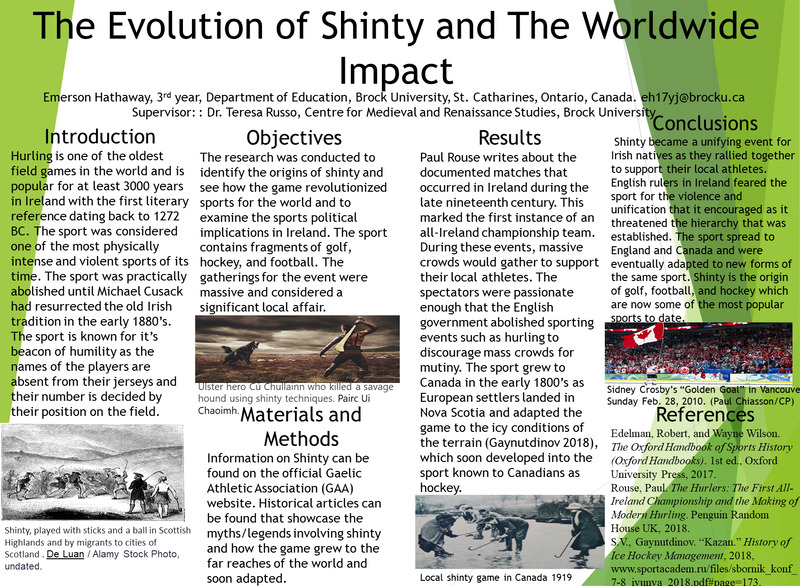The Evolution of Shinty and Its Worldwide Impact by Emerson Hathaway
The Evolution of Shinty and Its Worldwide Impact
Shinty/hurling is a stick and ball sport which was known for its violence and physical demands. Two teams comprised of 13 or 15 players would face off in a brutal engagement. Using a stick to knock a ball around the field, the teams must attempt to score a goal for three points or put the ball under the bar for one point. After 70 minutes of time, not including extra minutes for pauses in play, a winner is declared. The sport is considered one of the oldest and most violent stick and ball games known to Ireland. Injuries occurred frequently and were often broken bones in players’ hands. The players wore no protective equipment, but body contact was encouraged and accidental contact to the body with their sticks was very common. Irish communities would associate the sport with the highest adherence to toughness and athleticism. Myths and legends are weaved into the sport. The myth of Ulster hero Cu Chullainn is one of the most popular. In the tale, he marched to his uncle’s palace to learn the ways of hurling and of war. On arrival, he single-handedly defeated 150 boys in a match of shinty. After the game, he defeated a savage hound by hurling his ball down its throat (Britannica, 2017). Although it is a violent sport, it is also considered one of the humblest sports in history. The names of the players are left off the jerseys and their numbers are assigned by their position on the field. This does not allow a player to be singled out as an individual but rather a product of the team or society that they are representing. This installed more of a collective pride compared to an individual’s achievements.
The political aspects of hurling are seen through the English rule of Ireland in the nineteenth century. The games would attract massive crowds that pooled together to support their respective local hurling teams. The English rulers abolished the game because of the potential threat that the large crowds posed. A mutiny could arise swiftly in the aggressive and intoxicated crowds. In the late nineteenth century, the first All-Ireland team challenged their English counterparts to a game of shinty. The Irish team walked through the city in a military formation, as if to say that this was a formal battle against the English (Rouse, 2018). After the victory on the field, the pride of the Irish grew substantially. The English rule would eventually come to an end in 1922.
As the Irish began to migrate to other parts of the world, the sport grew vastly. English and Irish travellers brought the sport to England where it is rumoured to have developed into football, both European football and American football. This is plausible because the game incorporated aspects from both games such as being able to carry the ball, the extra time allowed, and the points system/nets. One sport that has directly originated from shinty is hockey. When British soldiers and Irish people immigrated to Canada they landed on the shores of Nova Scotia. The games of British soldiers and immigrants to Canada, influenced by stick-and-ball games of First Nations, evolved to become a game played on ice skates, often played with a puck, and played with sticks made by the Mi'kmaq of Nova Scotia, according to S.V. Gaynutdinov in his study published in the History of Ice Hockey Management (2018). They adapted the stick and ball game to the icy terrain that they were now surrounded in. Games continued on frozen lakes and the Atlantic Ocean but were considered to be extremely dangerous as many participants fell through the ice and numerous did not resurface. This prompted the construction of the first indoor skating rink in Montreal in the year 1875.
The sport began to grow immensely with the same passion that the Irish had for their game, Shinty. The sport amassed to what it is known today as hockey, the most popular sport in Canada. Similar to festivals that would occur during a game of shinty, the sports that occur today are essentially their own festivals. In addition, events such as the World Juniors, hockey at the Olympics, and other large tournaments all stem from their origin in Ireland with the game Shinty.
Works Cited
Britannica, The Editors of Encyclopaedia. "Cú Chulainn". Encyclopedia Britannica, 27 Apr. 2017, https://www.britannica.com/topic/Cu-Chulainn. Accessed 11 February 2021.
Edelman, Robert, and Wayne Wilson. The Oxford Handbook of Sports History (Oxford Handbooks). 1st ed., Oxford University Press, 2017.
Rouse, Paul. The Hurlers: The First All-Ireland Championship and the Making of Modern Hurling. Penguin Random House UK, 2018.
S.V., Gaynutdinov. “Kazan.” History of Ice Hockey Management, 2018, www.sportacadem.ru/files/sbornik_konf_7-8_iyunya_2018.pdf#page=173.
Biography: Emerson Hathaway was a third-year student in the faculty of Education at Brock University in 2021. He majored in English Language and Literature with a minor in Mathematics. He has played hockey from a young age which influenced him to research this topic.
How to cite this research:
Hathaway, Emerson. "The Evolution of Shinty and Its Worldwide Impact." In Reading the Middle Ages, supvr. Teresa Russo and ed. Elizabeth Colantoni, (issue 2: The Origins of Sports and Games in the Middle Ages from East to West), Centre for Medieval and Renaissance Studies (MARS), Brock University, March 2021, Niagara (The Evolution of Shinty and Its Worldwide Impact by Emerson Hathaway · Reading the Middle Ages: Oral and Literate Cultures · Brock University Library). Digital Scholarship Lab (DSL), Tim Ribaric and Daniel Brett.
